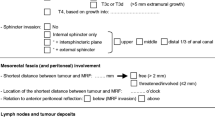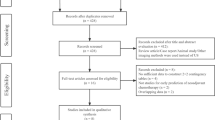Abstract
Purpose
To evaluate the role of magnetic resonance imaging (MRI) performed before and after neoadjuvant chemoradiotherapy (nCRT) in predicting risk of recurrence in rectal cancer and to investigate the prognostic significance of MR-detected extramural venous invasion (mr-EMVI) and of its regression after nCRT.
Methods
During 2005–2016, 87 patients with rectal cancer underwent pre- and post-nCRT MRI before surgery. Two radiologists independently reviewed MR examinations retrospectively, assessing T stage, nodal involvement, circumferential resection margin (CRM) status, and mr-EMVI. All four parameters assessed in pre- and post-nCRT MRI were correlated with the risk of recurrence. Correlation with disease-free survival (DFS) was investigated for significant predictive factors in pre-nCRT MRI and for mr-EMVI and its possible regression in post-nCRT MRI.
Results
15 of 87 patients developed recurrence, with a relapse-rate of 17.2%. Statistical analysis showed a significant correlation between CRM involvement and mr-EMVI assessed in pre-nCRT MRI and the risk of recurrence; 3 years-DFS in patients positive for these two parameters was significantly shorter compared with negatives. In post-nCRT MRI, all four parameters correlated significantly with recurrence: mr-EMVI affected significantly 3 years-DFS and its regression after nCRT correlated with a trend toward improvement of survival outcomes, although not statistically significant.
Conclusions
CRM involvement and mr-EMVI assessed in pre-nCRT MRI should be considered early predictive factors of recurrence in rectal cancer. MRI performed after nCRT has a significant value in predicting risk of recurrence: mr-EMVI confirmed to be a poor prognosis predictor and its regression or persistence after nCRT could have influences on treatment and follow-up strategies.






Similar content being viewed by others
References
MERCURY Study Group (2006) Diagnostic accuracy of preoperative magnetic resonance imaging in predicting curative resection of rectal cancer: prospective observational study. BMJ 333(7572):779. https://doi.org/10.1136/bmj.38937.646400.55
MERCURY Study Group (2007) Extramural depth of tumour invasion at thin-section MR in patients with rectal cancer: results of the MERCURY Study. Radiology 243:132–139. https://doi.org/10.1148/radiol.2431051825
Nougaret S, Reinhold C, Mikhael HW, et al. (2013) The use of MR imaging in treatment planning for patients with rectal carcinoma: have you checked the ‘‘DISTANCE’’? Radiology 268:330–344. https://doi.org/10.1148/radiol.13121361
Shihab OC, Taylor F, Salerno G, et al. (2011) MRI predictive factors for long-term outcomes of low rectal tumours. Annals of Surgical Oncology 18(12):3278–3284. https://doi.org/10.1245/s10434-011-1776-2
Bosset JF, Collette L, Calais G, et al. (2006) Chemotherapy with preoperative radiotherapy in rectal cancer. New England Journal of Medicine 355(11):1114–1123. https://doi.org/10.1056/NEJMoa060829
Chand M, Bhangu A, Wotherspoon A, et al. (2014) EMVI-positive stage II rectal cancer has similar clinical outcomes as stage III disease following pre-operative chemoradiotherapy. Annals of Oncology 25:858–863. https://doi.org/10.1093/annonc/mdu029
Petersen VC, Baxter KJ, Love SB, Shepherd NA (2002) Identification of objective pathological prognostic determinants and models of prognosis in Dukes’ B colon cancer. Gut 51:65–69
Roxburgh CS, McMillan DC, Richards CH, et al. (2014) The clinical utility of the combination of T stage and venous invasion to predict survival in patients undergoing surgery for colorectal cancer. Annals of Surgery 259(6):1156–1165. https://doi.org/10.1097/SLA.0000000000000229
Huh JW, Lee JH, Kim HR, Kim YJ (2013) Prognostic significance of lymphovascular or perineural invasion in patients with locally advanced colorectal cancer. American Journal of Surgery 206:758–763. https://doi.org/10.1016/j.amjsurg.2013.02.010
Horgan PG, McMillan DC (2010) Surgeons and selection of adjuvant therapy for node-negative colonic cancer. British Journal of Surgery 97:1459–1460. https://doi.org/10.1002/bjs.7254
Van Wyk HC, Roxburgh CS, Horgan PG, Foulis AF, McMillan DC (2014) The detection and role of lymphatic and blood vessel invasion in predicting survival in patients with node negative operable primary colorectal cancer. Critical Reviews in Oncology Hematology 90:77–90. https://doi.org/10.1016/j.critrevonc.2013.11.004
Talbot IC, Ritchie S, Leighton M, et al. (1981) Invasion of veins by carcinoma of rectum: method of detection, histological features and significance. Histopathology 5:141–163
Talbot IC, Ritchie S, Leighton MH, et al. (1980) The clinical significance of invasion of veins by rectal cancer. British Journal of Surgery 67:439–442
Liu L, Liu M, Yang Z, He W, Wang Z (2016) Correlation of MRI-detected extramural vascular invasion with regional lymph node metastasis in rectal cancer. Clinical Imaging 40:456–460. https://doi.org/10.1016/j.clinimag.2016.01.007
Betge J, Pollheimer MJ, Lindtner RA, et al. (2012) Intramural and extramural vascular invasion in colorectal cancer: prognostic significance and quality of pathology reporting. Cancer 118:628–638. https://doi.org/10.1002/cncr.26310
Smith N, Barbachano Y, Norman AR, et al. (2008) Prognostic significance of magnetic resonance imaging-detected extramural vascular invasion in rectal cancer. British Journal of Surgery 95:229–236
Smith N, Brown G (2008) Preoperative staging of rectal cancer. Acta Oncologica 47:20–31. https://doi.org/10.1080/02841860701697720
McClelland D, Murray GI (2015) A comprehensive study of extramural venous invasion in colorectal cancer. PLoS ONE 10:e0144987. https://doi.org/10.1371/journal.pone.0144987
Howlett CJ, Tweedie EJ, Driman DK (2009) Use of an elastic stain to show venous invasion in colorectal carcinoma: a simple technique for detection of an important prognostic factor. Journal of Clinical Pathology 62:1021–1025. https://doi.org/10.1136/jcp.2009.065615
Vass DG, Ainsworth R, Anderson JH, Murray D, Foulis AK (2004) The value of an elastic tissue stain in detecting venous invasion in colorectal cancer. Journal of Clinical Pathology 57:769–772. https://doi.org/10.1136/jcp.2003.015826
Smith NJ, Shihab O, Arnaout A, Swift RI, Brown G (2008) MRI for detection of extramural vascular invasion in rectal cancer. AJR. American Journal of Roentgenology 191:1517–1522. https://doi.org/10.2214/AJR.08.1298
Brown G, Radcliffe AG, Newcombe RG, et al. (2003) Preoperative assessment of prognostic factors in rectal cancer using high-resolution magnetic resonance imaging. British Journal of Surgery 90:355–364. https://doi.org/10.1002/bjs.4034
Chand M, Evans J, Swift RI, et al. (2015) The prognostic significance of post chemoradiotherapy high-resolution MRI and histopathology detected extramural venous invasion in rectal cancer. Annals of Surgery 261:473–479. https://doi.org/10.1097/SLA.0000000000000848
MERCURY Study Group, Shihab OC, Taylor F, et al. (2011) Relevance of magnetic resonance imaging-detected pelvic sidewall lymph node involvement in rectal cancer. Br J Surg 98(12):1798–1804. https://doi.org/10.1002/bjs.7662
Brown G, Richards CJ, Bourne MW, et al. (2003) Morphologic predictors of lymph node status in rectal cancer with use of high-spatial resolution MR imaging with histopathologic comparison. Radiology 227(2):371–377. https://doi.org/10.1148/radiol.2272011747
Kim JH, Beets GL, Kim MJ, Kessels AG, Beets-Tan RG (2004) High-resolution MR imaging for nodal staging in rectal cancer: are there any criteria in addition to the size? European Journal of Radiology 52(1):78–83. https://doi.org/10.1016/j.ejrad.2003.12.005
Taylor FG, Quirke P, Heald RJ, et al. (2011) One millimetre is the safe cut-off for magnetic resonance imaging prediction of surgical margin status in rectal cancer. British Journal of Surgery 98(6):872–879. https://doi.org/10.1002/bjs.7458
Chand M, Swift RI, Tekkis PP, Chau I, Brown G (2014) Extramural venous invasion is a potential imaging predictive biomarker of neoadjuvant treatment in rectal cancer. British Journal of Cancer 110:19–25. https://doi.org/10.1038/bjc.2013.603
Taylor FG, Quirke P, Heald RJ, et al. (2011) Preoperative high-resolution magnetic resonance imaging can identify good prognosis stage I, II, and III rectal cancer best managed by surgery alone: a prospective, multicenter. European study. Ann Surg 253(4):711–719. https://doi.org/10.1097/SLA.0b013e31820b8d52
Glynne-Jones R, Wyrwicz L, Tiret E, et al. (2017) Rectal cancer: ESMO Clinical Practice Guidelines for diagnosis, treatment and follow-up. Ann Oncol 28(suppl_4):iv22-iv40. https://doi.org/10.1093/annonc/mdx224
Lee ES, Kim MJ, Park SC, et al. (2018) Magnetic Resonance Imaging-Detected Extramural Venous Invasion in Rectal Cancer before and after Preoperative Chemoradiotherapy: Diagnostic Performance and Prognostic Significance. Eur Radiol 28(2):496–505. https://doi.org/10.1007/s00330-017-4978-6
Patel UB, Taylor F, Blomqvist L, et al. (2011) Magnetic resonance imaging-detected tumor response for locally advanced rectal cancer predicts survival outcomes: MERCURY experience. J Clin Oncol 29(28):3753–3760. https://doi.org/10.1200/JCO.2011.34.9068
Author information
Authors and Affiliations
Corresponding author
Ethics declarations
Conflict of interest
The authors declare that they have no conflict of interest.
Rights and permissions
About this article
Cite this article
Prampolini, F., Taschini, S., Pecchi, A. et al. Magnetic resonance imaging performed before and after preoperative chemoradiotherapy in rectal cancer: predictive factors of recurrence and prognostic significance of MR-detected extramural venous invasion. Abdom Radiol 45, 2941–2949 (2020). https://doi.org/10.1007/s00261-018-1838-z
Published:
Issue Date:
DOI: https://doi.org/10.1007/s00261-018-1838-z




